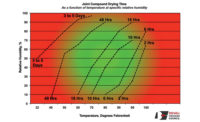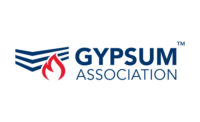ALL THINGS GYPSUM
Quality Educational Environments

Capital Public Charter School, Washington, D.C. Courtesy Shinberg.Levinas

Anacostia Senior High School, Washington, D.C. Courtesy Sorg Architects, photo credit Anice Hoachlander

Stoddert Elementary School & Community Center, Washington, D.C. Courtesy Perkins Eastman, photo credit Joseph Romeo
Today’s learning environments differ significantly from those of even a few decades ago. PowerPoint and digital image projection technologies have replaced black boards, transparencies and overhead projectors so common in the 1960s and 1970s. Yet, dedicated computer projection systems and interactive whiteboards are not the only ways in which schools have changed from the chalkboard era.
A recent spate of new school construction and extensive renovations in the Washington Metropolitan-area, the same region where I spent much of my childhood, demonstrates how building technology is also transforming learning environments. Within the past decade, for example, over two thirds of the District of Columbia’s 109 schools have been renovated or fully modernized. The bunker-like aesthetic of baby-boomer schools may have been appropriate to the cold war era. These days, tiled halls, concrete block classrooms and linoleum floors have given way to new wall finishes and far greater attention to sound control.
Local School Renovations
Looking at images of recent school projects in the District of Columbia and Maryland, I noticed that gypsum panel products are now replacing many traditional wall coverings both in new construction and renovations. It makes sense. Heavier and denser by design, abuse and impact resistant gypsum products are readily available and extend the aesthetic and structural integrity of wall assemblies.
To confirm my impression, I spoke with three architectural firms that have worked on numerous school renovations and addition projects in Washington, D.C. Sorg Architects, is a female owned design practice located in the District of Columbia with a lengthy portfolio of national and international work. Shinberg.Levinas is another D.C.-based firm with extensive experience in public and private educational facilities. Perkins Eastman, an international design, planning and consulting firm with seven offices in the U.S. and five overseas, has a practice area dedicated to K-12 educational facilities. Each conversation revealed numerous reasons why gypsum panel products are so attractive to designers working in the K-12 realm.
According to firm principal, Rachel Chung, AIA, PMP, of Sorg Architects, the standardized appearance of so many schools built in the 1950s, 1960s and 1970s, is completely passé not only in terms of uniformity but also its no nonsense look and feel.
“The materials selected for schools are more comfortable and soothing, now,” Chung says. Sorg architects works directly with students and personalizes learning environment with their needs and desires in mind. When it comes to school projects, students aren’t the firm’s only clients, but rather one end-user group that includes the administration and the maintenance department.
“Some school systems have certain standards they want the architect to use,” she says. “In all cases, we look at what is locally and regionally available. If repairs are necessary we don’t want to use specialty products that need to be ordered. We always try to use standard materials to create a unique look.”
Salo Levinas, Assoc. AIA, principal, Shinberg.Levinas, noted the desire for customization combined with strict budget limitations makes creativity essential and gypsum panel products very appealing. “Today cost is a big issue, yet even in a renovation we can improve schools dramatically, by designing a customized look for each school,” Levinas says. “For us it is important to create an identity for each school. We try very hard to understand who the client is—the kids in that particular location—and bring the neighborhood into the school. With gypsum panel products we can bring texture and color into the school in an economical way. We can even do more with ceilings by getting obstruction of sound. There is far more flexibility, as well.”
Even when public areas are surfaced with traditional block or tile, the approach to application is less monolithic these days. “Often times, in response to cost and availability, we look at using different materials in areas higher than you can reach. Here is one place where abuse resistant gypsum products are not only useful products but also offer a lot of flexibility in application in terms of color and reveals as opposed to CMU or block,” Chung says.
The Writing is on the Wall
The walls Sorg designed at Anacostia Senior High School are a case in point. The original school was built in 1935 with subsequent additions in the 1940s, 1950s and 1970s that created 247,000 square-feet of space, most in desperate need of renovation. Here corridors above the wainscot were given an acoustical treatment using student art work mounted with Velcro over gypsum wallboard.
“Showcasing student work creates ownership,” says Chung. “That artwork is the kids.” And she adds that the wall treatment is both sturdy and flexible enough to mount new work every few years.
In the classrooms, Chung stressed, “It is very important not to have distraction from noise of hallways.” In areas where sound control was particularly desirable, the firm avoided creating plenum ceilings. In many classrooms, original clay tiles were removed and walls were rebuilt with metal studs and abuse resistant gypsum panels. Some of the project’s walls were quite old and not plumb, in these cases “Furring it out and applying a gypsum product really helps,” she explains. To avoid future maintenance issues, she says the firm pays close attention both to the finishes selected and the intersection between the floor and the wall. Metal angles are frequently installed to reinforce and protect the wall assemblies.
Particularly challenging for Shinberg.Levinas was a 2003 project creating a school within a 1912 masonry and stone building that had once served as a sanctuary for the National Presbyterians. The façade of this neoclassical building in the Mt. Pleasant neighborhood was preserved, while the interior structure was removed and a new structure dropped in to serve Capital City Public Charter School’s pre-K through 8th grade students. Capital City is one of 52 charter schools in Washington, D.C.
“It is a very important building,” Levinas says. “A facility like that—downtown—is hard to find.” The new interior used gypsum panel products extensively to absorb and deflect sound. To accommodate the building’s transformation into an educational environment, Levinas says, “We tried to capture the spirit of the client and to materialize it inside the building. In this way, students feel comfortable. We want [school] to feel like a second home.”
Part of the strategy included engaging the students with the Smithsonian’s National Museum of African Art where they learned to paint in the style of one tribe from South Africa. Under the direction of Smithsonian staff, Levinas says, “The kids created a mural, painting on the drywall. When they came into the new building it was there, it was familiar to them.”
It’s All for the Kids
Washington-based Sean O’Donnell, AIA, LEED AP, a principal at Perkins Eastman, has devoted 20 years to designing and researching successful learning environments. Over the years, he has explored many aspects of what makes a school work well for students, and has become something of an advocate for adaptive reuse of existing school buildings. Through lectures and articles he has examined how school buildings can accommodate technological advances and new security concerns within environments that are welcoming and supportive.
“I do think over my 20 years of practice, we use wallboard more commonly now than we used to,” O’Donnell says. “Cost was the initial motivator. When high impact boards came out, we realized we could provide robust walls with more flexibility.” Moreover, he says by using the proper wallboard assembly he has been very successful with sound control, earning LEED points by meeting enhanced acoustical criteria for schools.
He points out that today’s more active learning styles result in a noisier school environment. A researcher made an interesting point, he tells me, “You can have all the daylight in the world but if you can’t hear, you can’t learn.” For precisely that reason, he says, “We typically push clients to aim for a greater level of [sound control] performance.” Moreover he advocates for adding acousticians to the design team. “Pre-LEED this was a hard sell,” he admits. “Now, acousticians are one of our greatest collaborators in creating high performance learning environments.”
The enthusiasm these designers express for their work with schools is clear. They seem to embrace the constraints imposed by existing and outdated educational buildings precisely because it allows them to exercise their creativity and knowledge. Advancing abuse and impact resistant gypsum panel selections has been a significant arena for applied research and technological improvement among Gypsum Association member companies. It was a pleasure to learn the many ways our member companies’ commitment to quality and innovation are contributing to improved K-12 educational environments.
Of course, it should be noted that where abuse and impact resistant panels are specified, greater expertise in cutting and fastening is key. Also, framing must be evaluated for installation compatibility with the desired level of abuse resistance. Heavier gauge steel studs are recommended to achieve desired performance and constructability. Fastener length, type and spacing may require redesign over standard construction. Individual manufacturer literature and Web sites provide specific guidance for appropriate use and installation of their products.
Looking for a reprint of this article?
From high-res PDFs to custom plaques, order your copy today!





